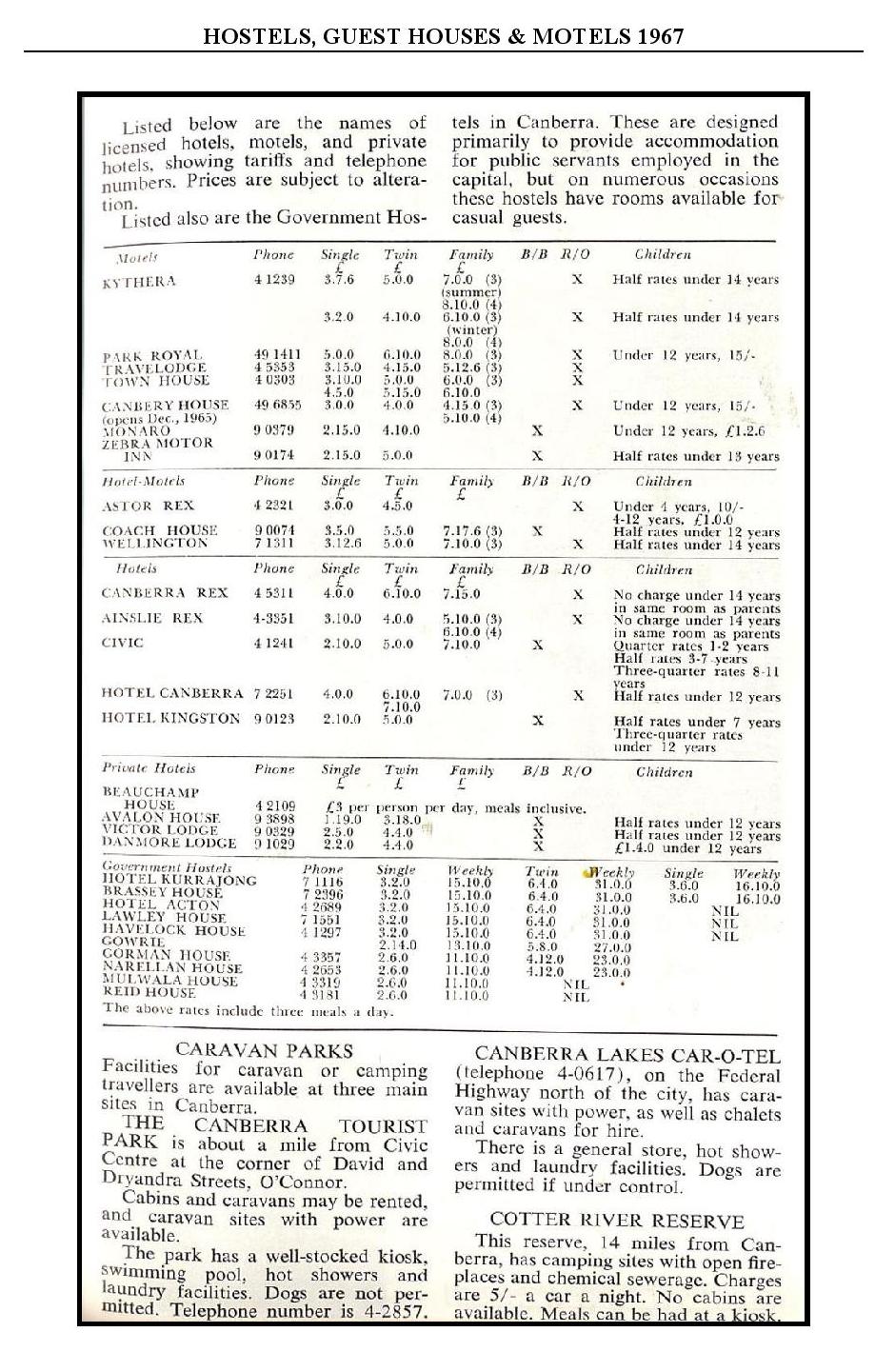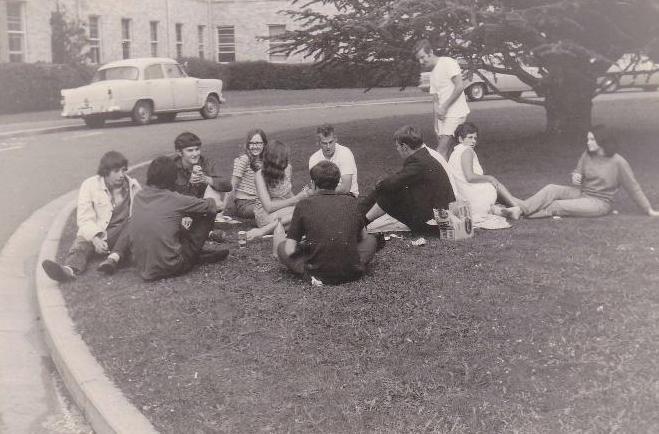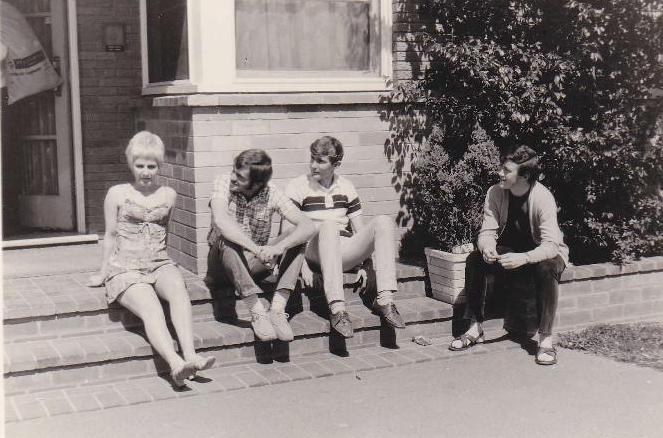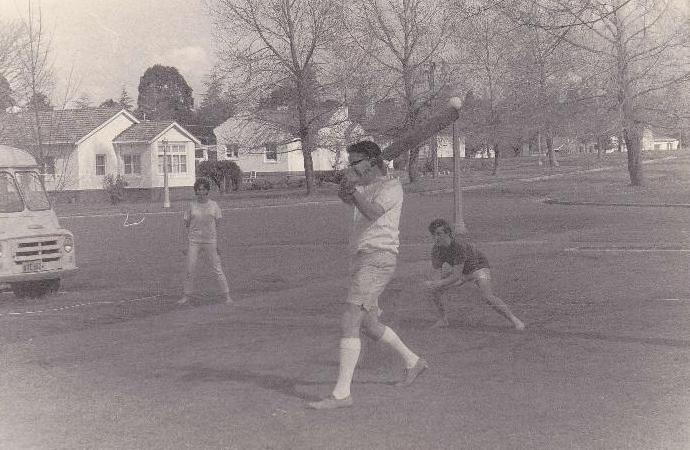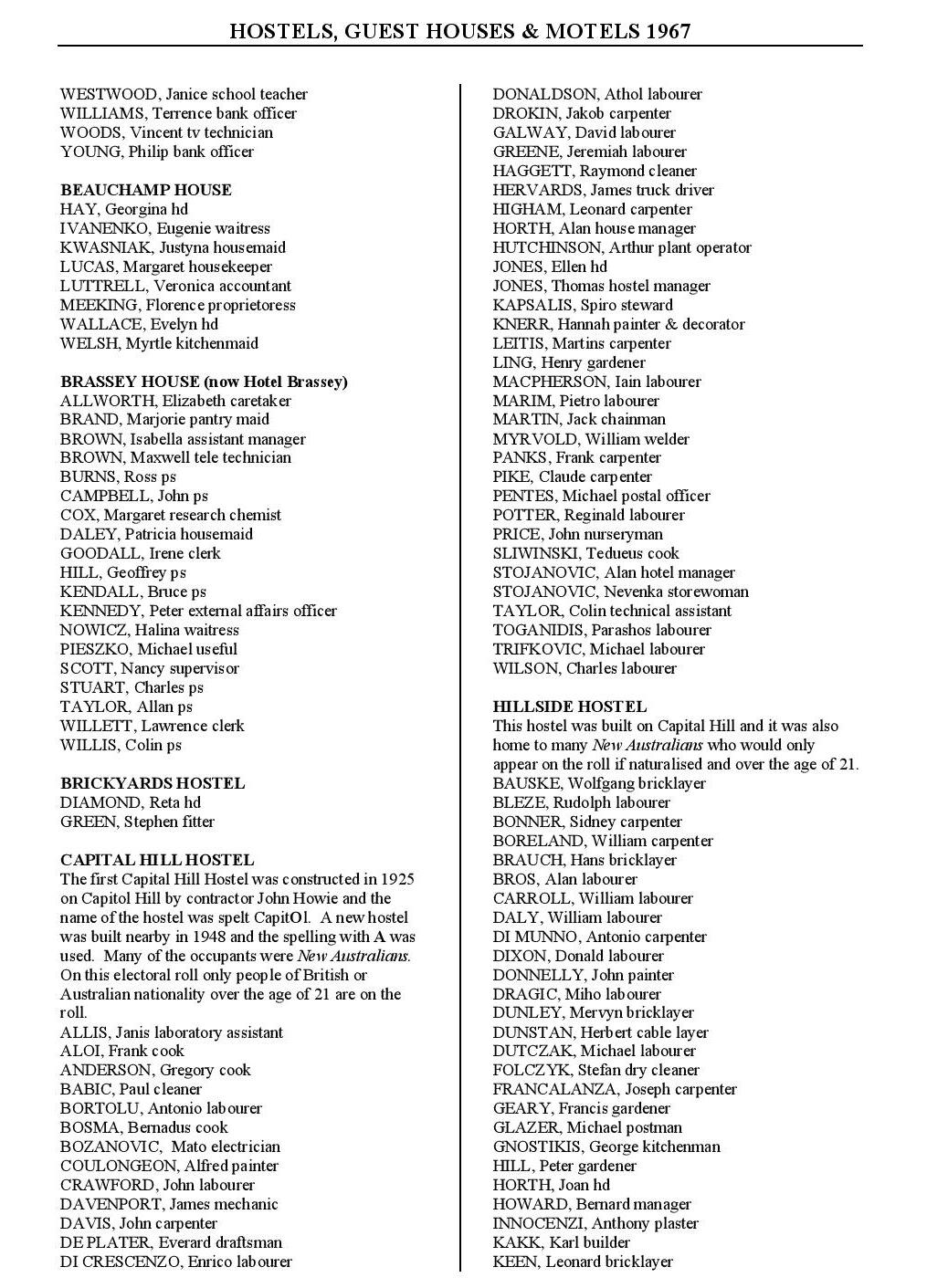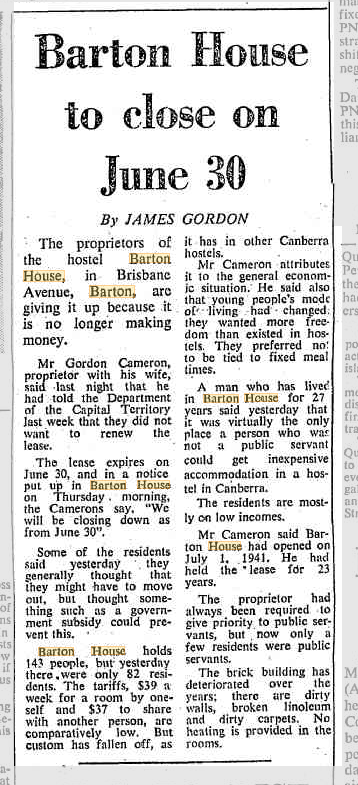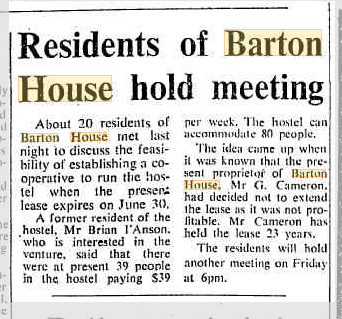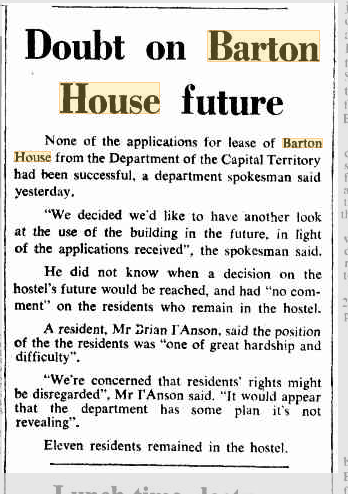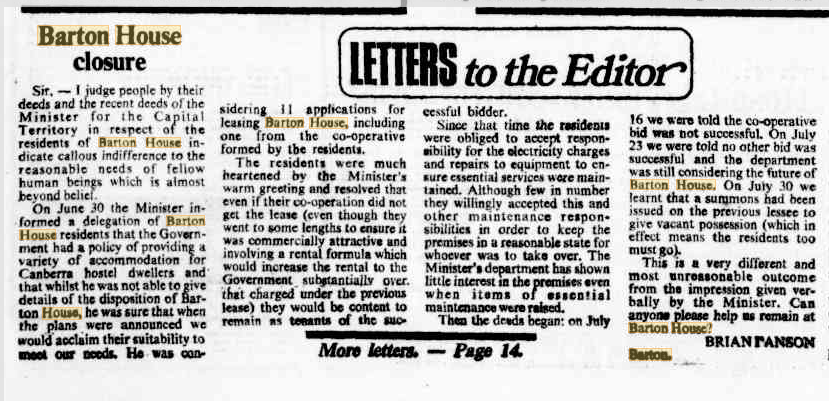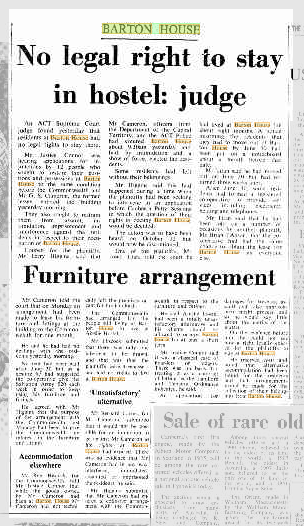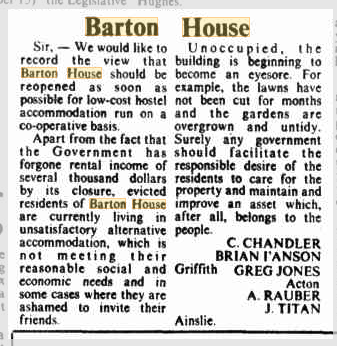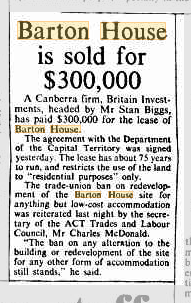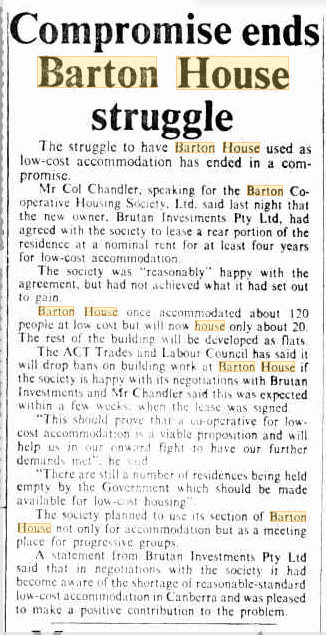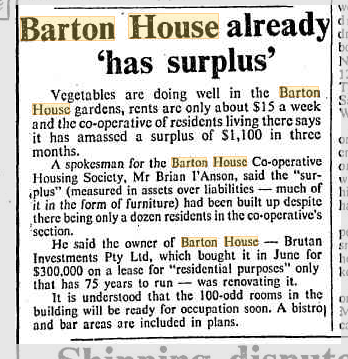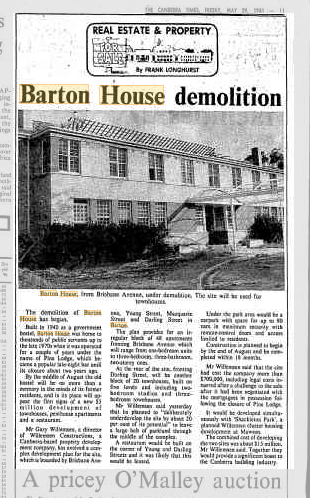Welcome to Barton House! |
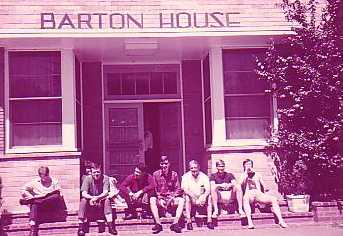 Sunday morning after the night before: chilling out on the front steps; "yours truly" in dead centre, wearing sunnies and checkered shirt. Notice the chap on the far right having a "hair of the dog" from a McWilliams flagon left over from the night before. If that didn't do it, there was always BEX powder and a good lie down! Or take Vincent's with confidence for quick three-way relief. All things of the past now! As is Barton House itself which was demolished in 1981.
It was 1965. The Menzies era was coming to an end. The conflict in Vietnam was escalating. And I had just come out to Australia as a young migrant from Germany. I spent those early years, from 1965 to 1967, and then again a brief period in 1969 after I had come back from South Africa, in Canberra in a place called "Barton House" in Brisbane Avenue, one of the many boarding houses then in existence.
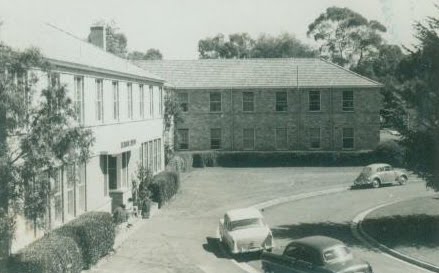
Those were the days of parties, of evenings in front of the telly in the TV Room watching "Z-Car" or "M*A*S*H", laughing at the antics of Agent 99 and Maxwell Smart in "Get Smart" ("Good thinking, 99" was a favourite saying in those days); or being bored to death by Barry Jones's insufferable show-off act on Bob and Dolly's BP Pick-a-Box. And then there were the evenings spent at the Burns Club or in the Newsroom of the "Wello" Pub across the road, drinking 'schooners' and talking about 'sheilas', followed by a last-minute dash back to Barton House before the dining room closed! And Sunday morning, sitting on the frontsteps with the boys, recovering from the night before, while waiting for the week's washing to run through its cycle in the laundry in the backyard.
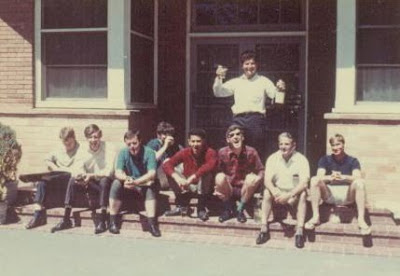
It was at Barton House that I was introduced to the culinary delights of Australia in the 60s: mixed grill, corned silverside, Yorkshire pudding, spaghetti-meatballs, lamp chops, and, as a filla-uppa, loads and loads of steam-pudding drowned in thick creamy custard. And who can forget those dreadful brown-paperbag luncheon packs of baked-beans sandwiches, chutney sandwiches, and spaghetti sandwiches? Is there anything more revolting than a soggy spaghetti-sandwich dripping through the bottom of a brown paperbag? The people who ate that stuff must've been a weird mob indeed! There were never any seconds - except for steam-pudding!!! - and for a growing lad that meant going next door to the "Greasy Spoon" at Lachlan Court to stock up on Iced Vovos, Arnott's Spicy Fruit Rolls (my favourites!), and spring and Chiko rolls.

I always occupied a share-room because a share-room was cheaper. And some of the room mates I had to share with! There was the ANZ "Bank Johnny" from the Kingston branch who regularly came back drunk, night after night, and who was a master of the Australian expletive - which he used constantly, stand-alone, in between words, even inserted into words! Watching him at the Bank stringing together sentences without profanity was like watching someone trying to swim across a river without using his arms or his legs. And the WORMALD-employee who would purposefully strut off to work only to be back inside the room five minutes later, screaming his head off. "They repossessed my car again, the bastards!!!" He regularly fell behind with his repayments, and regularly had his car repossessed.
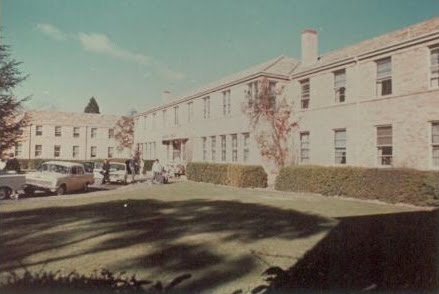
And then there was the postie who seemed to lead a charmed life as he was usually back from work by mid-morning until he was found out to have dumped his mail deliveries at the local tip! And the Kiwi with his already then wonderfully antique ROVER-car with walnut dashboard who loved classical music and played it throughout the night on his radiogram. Remember the radiogram? His was an expensive "HIS MASTER'S VOICE ". My own choice of music at the time were THE SEEKERS and PETER, PAUL AND MARY. There will never be another time like that! And could I write a book about it? You bet!!! There was a constant stream of new arrivals, but for a hard core of people - and that included me! - Barton House was "home" because we had no other! The home we never left, not even for Christmas, when it became a ghostly place with just a handful of us scattered along its empty corridors and we sat like lost sheep in a small 'holding pen' of the otherwise closed-off dining room. It was the sort of "home" that prepared me well for the house I later shared in Rabaul with two fellow-accountants and the camp accommodation I occupied when I went to Bougainville Island. And it gave me the confidence and the skills to deal with all manner of people in future years.
And what variety of people I met, and what interesting friends I made! Some of the names I still remember are John Burke, my immediate boss at the Bank, Merv Quine, another "Bank Johnny" originally from Broken Hill, the other two "Bank Johnnies" Dennis Everitt and Bob Southwell, Pat Fisher from Foreign Affairs who was forever on study leave trying to learn some foreign languages but never getting past the equivalents of "Good Morning" and "How are you?". And Jerry from the Government Printers who somehow or other broke his leg and stayed on crutches for years and years, creaming off the insurance companies. The retired dotty surveyor, known as "The Colonel", who spoke to no-one and always walked about with his own cutlery in his pockets. In the mornings he would stand outside the communal shower cubicles and rap his walking-stick on the door if anyone dared to stand under the shower beyond what he considered was a reasonable time.

No photo of Barton House's dining room exists; this is as close as it gets with nearby more upmarket Brassey House's as a fill-in
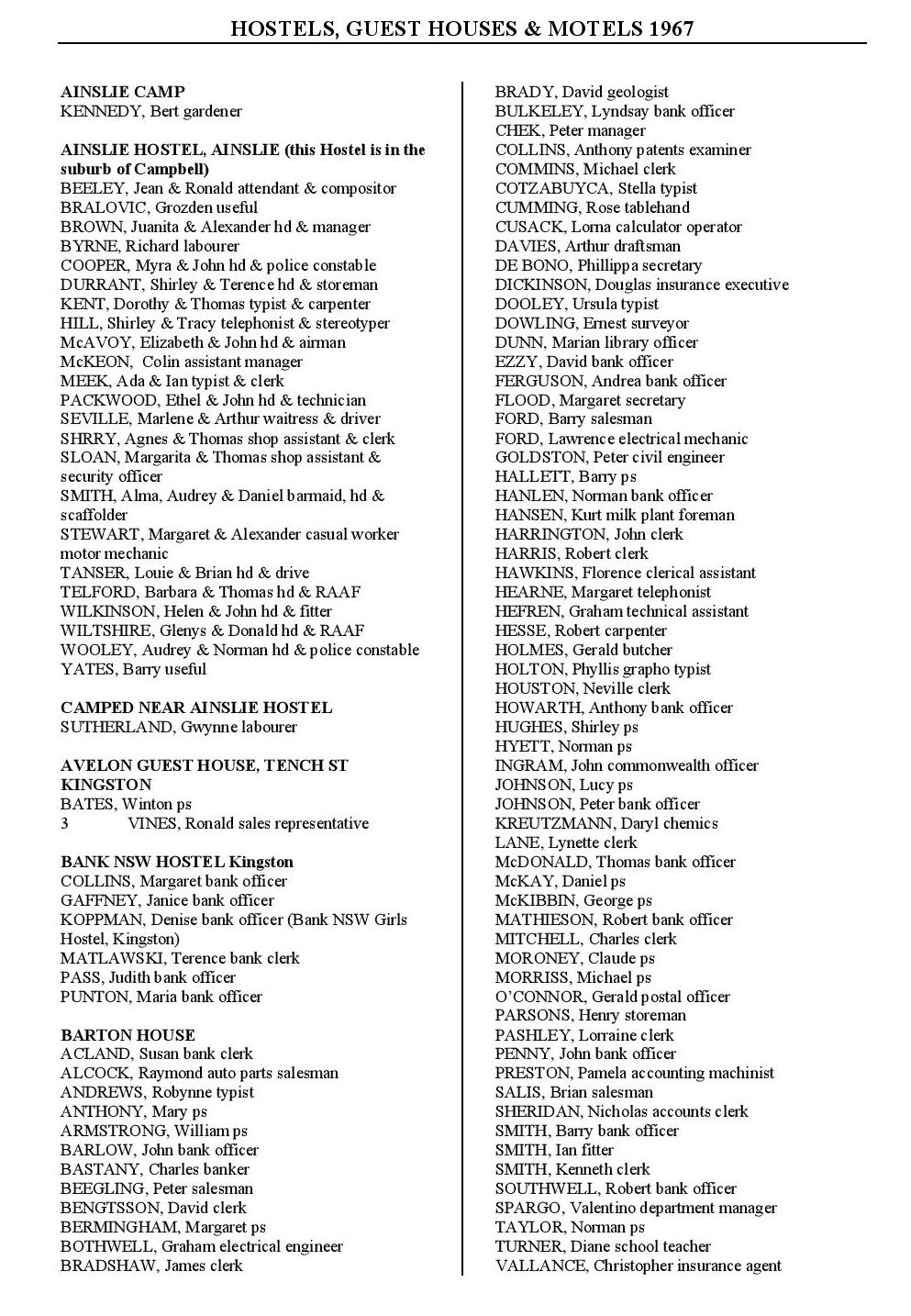
For years after, and in different parts of Australia, I still kept bumping into people who had been at Barton House, who had been chased for their outstanding rents by Peter "Frenchie" Chek, the manager, who also ran an "Academy of Self-Defense" (and didn't he need it to deal with some of his more difficult boarders!) They all looked back on their time there with fond memories and a great deal of nostalgia.
 Soaking up the sun on the front steps of Barton House: half of yours truly, Colleen Murray, her roomie Dulcie, and Denva Boardman If you were at one time or another an "inmate" of Barton House and have pictures and memories to share, please email me this very moment at riverbendnelligen@mail.com! I shall collect all comments and snaps on this website which, hopefully, will grow as time goes on. With best wishes to whoever and wherever you are! Peter, an ex-ANZ "Bank Johnny"
P.S. Barton House is no more! It fell victim to the economics of the time and the developers who turned it into a pile of strata-titled luxury apartments - below:
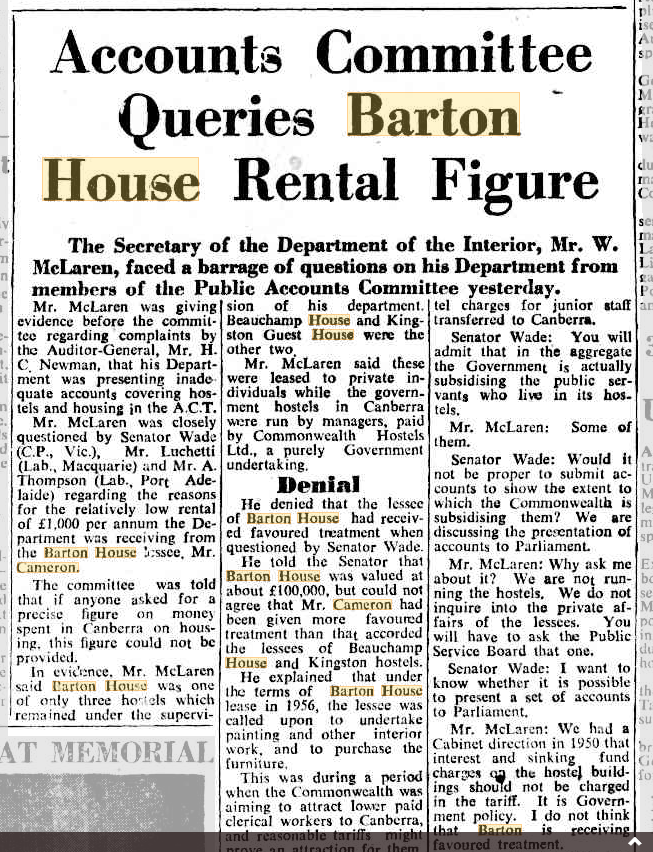
Canberra Times, 11 May 1960 Just £1000 per annum for the lease? Mr Cameron must've made a fortune out of that place. I mean I paid more than that in a year for just a share-room!
Mr Justice Connor was hearing applications for in junctions by 12 people who sought to restore their posi tions and possessions at Barton House to the same condition before the Commonwealth and Mr G. S. Cameron, the former lessee, entered the 'building yesterday morning. They also sought to restrain them from assault, in-, timidation, imprisonment and interference against the resi dents in respect to their occu pation of Barton House. Counsel for the plaintiffs, Mr Terry Higgins, said that Mr Cameron, officers from the Department of the Capital Territory, and the ACT Police had' entered Barton House about 9.30am yesterday and had, by intimidation and a show of force, ejected the resi dents. Some residents had left without their belongings. Mr Higgins said this had happened during a time when the plaintiffs had been seeking to intervene in an application before Canberra Petty Sessions in which the question of their rights to occupy Barton House would be decided. The action was to have been heard on October 12 but would now be discontinued. One of the plaintiffs, Mr Josef Titan, told the court he had lived at Barton House for about eight months. A notice informing the residents that they had to move out of Bar ton House by June 30 had been put on a noticeboard abbut a month before that date. Mr Titan said he had moved out on June 30 but had returned three weeks later. After June 30, some residents had formed a registered co-operative to provide services including electricity, heating and telephones. Mr Titan said that he had been told on a number of occasions by another plaintiff, Mr Brian I'Anson, that the co-operative had had the same chance to obtain the lease for Barton House as everyone else. Furniture arrangement Mr Cameron told the court that on Monday an arrangement had been made to lease his furniture and fittings at the building to the Commonwealth for one month. He said he had had no dealings with the residents yesterday morning. No rent had been paid after June 30 but as a gesture he had suggested the co-operative give the Salvation Army $20 each week in order to keep using his furniture and fittings. He agreed with Mr Higgins that the purpose of the arrangement with the Commonwealth last Monday had been to give the Commonwealth an interest in the furniture and fittings. Accommodation elsewhere Mr Reg Hiscock, for the Commonwealth, told Mr Justice Connor that while the goods owned by Mr Cameron had been at Barton House Mr Cameron had not technically left the premises vacant for the landlord. The Commonwealth had arranged for the people still living at Barton House to live at Ainslic Hostel. Mr Hiscock submitted that there was only one inference to be drawn, and that was that the plaintiffs were trespassers and had no rights to live at Barton House. 'Unsatisfactory' alternative Mr Bernard Cairns, for Mr Cameron, submitted that it would not be possible for an injunction to go against Mr Cameron as his rights at Barton House had expired. There was no evidence that Mr Cameron had in any way interfered, intimidated, assaulted or imprisoned the residents, he said. Mr Higgins submitted that Mr Cameron had entered a collusive arrangement with the Commonwealth in respect to the furniture and fittings. He said Ainslie Hostel had been a totally unsatisfactory alternative and his clients should be allowed to occupy Barton House for at least a short term. Mr Justice Connor said it was a classical case of boarders or lodgers. There was no basis for treating it as 'a contract of letting' as the Landlord and Tenants Ordinance indicated, he said. An application for damages for 'trespass, assault and false imprisonment' might proceed and so he would say little about the merits of the matter. On the evidence before him, he could not see how a right legally existed for the plaintiffs to stay at Barton House. He reserved costs and noted that alternative accommodation had been found for the residents and that arrangements would be made for the collection of their belongings from Barton House.
Mr Col Chandler, speaking for the Barton Co-operative Housing Socicty Ltd, said last night that the new owner, Brutan Investments Pty Ltd, had agreed with the socicty to lease a rear portion of the residence at a nominal rent for at least four years for low-cost accommodation. The society was "reasonably" happy with the agreement, but had not achieved what it had set out to gain. Barton House once accommodated about 120 people at low cost but will now house only about 20. The rest of the building will be developed as flats. The ACT Trades and Labour Council has said it will drop bans on building work at Barton House if the socicty is happy with its negotiations with Brutan Investments and Mr Chandler said this was expected within a few weeks, when the lease was signed. "This should prove that a co-opcrative for low cost accommodation is a viable proposition and will help us in our onward fight to have our further demands met", he said. "There arc still a number of residences being held empty by the Government which should be made available for low-cost housing". The society planned to use its section of Barton House not only for accommodation but as a meeting place for progressive groups. A statement from Brutan Investments Ply Ltd said that in negotiations with the socicty it had bccomc aware of the shortage of reasonable-standard low-cost accommodation in Canberra and was pleased to make a positive contribution to the problem.
Members approved at their annual meeting on Wednesday night a board of directors recommendation for a cash dividend of 12.5c a share and a share dividend of 87.5 cents a share to be applied to uncalled portion of issued shares. The co-operative continues to provide low-cost accommodation — $8 a week for students, pensioners and the unemployed and $ 15 a week for the employed, In addition, the co-operative has bought a house at Narrabundah which it is leasing out as low-cost, apartment-type accommodation and it has just arranged to lease another house in Narrabundah with the possibility of leasing another two if demand and viability are demonstrated. The chairman of the co-operative, Mr Brian I'Anson, attributes the success of the co-operative to the fact that there are no direct managerial costs. This work is done voluntarily. Residents make the effort to look after themselves in order to save money. Also, in times of economic downturns, cooperatives survived better than more highly-geared institutions because they did not have to make a profit. Mr I'Anson said the success of the co-operative effectively put the lie to the sceptics that it would not succeed. "Not only have we succeeded but we are one of the few bright spots in the Canberra commercial market these days", he said. "We are still alive and going from strength to strength. Our membership has increased from 50 last year to about 80". At the annual meeting, which was attended by about 25 members, the directors' recommendation on dividends had been accepted after considerable debate. The co-operative was formed in 1976 when residents of Barton House were faced with eviction after the proprietors decided not to renew their lease with the Department of the Capital Territory because they were no longer making money. Mr I'Anson was the last resident in October 1976. He left after a court order and the hostel was closed. The Trades and Labour Council in the ACT placed a black ban on the demolition of the building. The co-operative had offered to lease the building and run it as a hostel but this and other offers were rejected by the then Minister for the Capital Territory, Mr Staley. A compromise was reached when the new owner agreed to lease a rear portion of the building to the co-operative at a nominal rent for four years with an option for a fifth.
Built in 1940 as a government hostel, Barton House was home to thousands of public servants up to the late 1970s when it was operated for a couple of years under the name of Pine Lodge, which became a popular late-night bar until its closure about two years ago. By the middle of August the old hostel will be no more than a memory in the minds of its former residents, and in its place will appear the first signs of a new $5 million development of townhouses, penthouse apartments and a restaurant. Mr Gary Willemsen, a director of Willemsen Constructions, a Canberra-based property development company, has evolved a complex development plan for the site, which is bounded by Brisbane Avenue, Young Street, Macquarie Street and Darling Street in Barton. The plan provides for an irregular block of 48 apartments fronting Brisbane Avenue which will range from one-bedroom units to three-bedroom, three-bathroom, two-storey ones. At the rear of the site, fronting Darling Street, will be another block of 20 townhouses, built on five levels and including two bedroom studios and three bedroom townhouses. Mr Willemsen said yesterday that he planned to "deliberately underdevelop the site by about 20 per cent of its potential" to leave a large belt of parkland through the middle of the complex. A restaurant would be built on the corner of Young and Darling Streets and it was likely that this would be leased. Under the park area would be a carpark with space for up to 90 cars in maximum security with remote-control doors and access limited to residents. Construction is planned to begin by the end of August and be completed within 18 months. Mr Willemsen said that the site had cost the company more than $700,000, including legal costs incurred after a challenge to the sale after it had been negotiated with the mortgagees in possession following the closure of Pine Lodge. It would be developed simultaneously with 'Shackleton Park', a planned Willemsen cluster housing development at Mawson. The combined cost of developing the two sites was about S15 million, Mr Willemsen said. Together they would provide a significant boost to the Canberra building industry.
|
